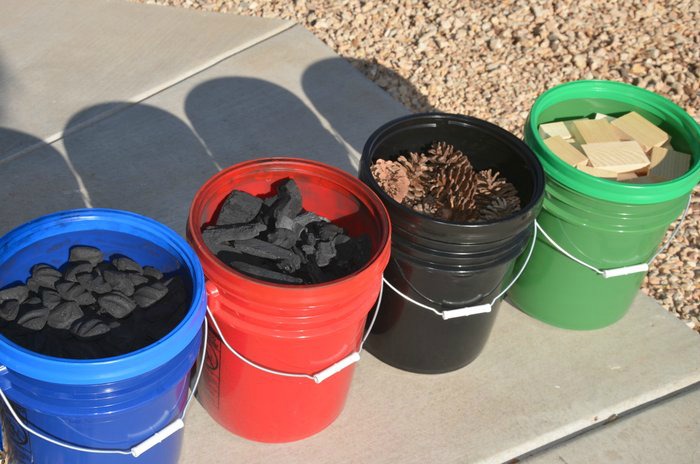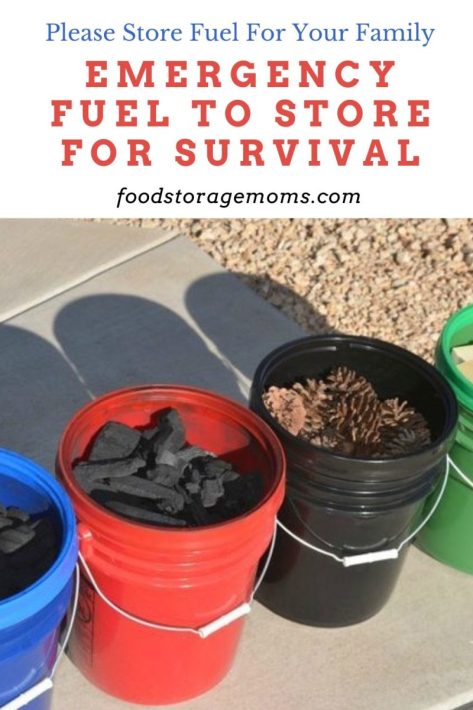
My favorite emergency fuel to store for survival is also one of my favorite topics to talk about, so that you know. I have a small yard, so I cannot store as much as someone with a large property. If I had a large parcel of land, I would have a large truckload of my favorite charcoal/coal delivered. (I don’t own a truck.) Emergency fuel is an important topic, so I updated this post from several years ago. I’ve updated this post to get the word out about storing fuel.
Emergency Fuel
I purchased several red five-gallon buckets with red Gamma lids to store my Ozark Oak hardwood lump charcoal. I chose to buy this brand of charcoal because I read about the chemicals in the barbecue charcoal briquettes you buy at grocery stores or large box stores. I’m not a scientist, but I’ll give you some tips on what to buy based on what I’ve researched.
I started buying Ozark Oak hardwood lump charcoal several years ago. They have now closed their doors and are no longer in business. Dang! I have had to order it online for years, but now I’m seeing other brands of lump charcoal at major hardware stores. I haven’t researched those companies because I have so much Ozark product on hand, I’m set for my lifetime.
If you store your fuel properly, it will last indefinitely, except for butane. I store only about 12 canisters of that product. Propane must be stored upright and several feet away from your home. I store all my propane outside, not in the garage. Remember, it is combustible. If the propane containers don’t rust, they’ll store indefinitely if you keep them upright.
I store my charcoal briquettes in blue-colored Gamma lid 5-gallon buckets. Anyone who knows me knows my organizational skills, or whatever you want to call them. I have my washed and baked pinecones (to get rid of bugs and sap) in black 5-gallon containers with black Gamma lids. The freshly cut wood pieces are in 5-gallon green containers with green Gamma lids.
There is no question regarding how much fuel I have available because I have the colored containers lined up in my garage. Please note, I don’t buy charcoal briquettes with the lighter fluid embedded in them. The regular charcoal briquettes without the fluid will last indefinitely if stored in air-tight containers. I realize some people store the briquette bags all stacked up, but I prefer air-tight containers. Gamma Lids and Colored 5-gallon buckets store and stack so easily, they are a lifesaver for me.

Emergency Fuels
Propane:
Stores indefinitely if the containers are stored upright and don’t rust. I can use propane with my Volcano Stove. If you buy one, ensure you have the correct size adapter for the large tanks or the smaller propane canisters, depending on which size you prefer. Different Volcano stoves are sold with varying adaptors of various sizes. Propane Tanks: I would check Sam’s Club, Walmart, or Costco to buy your tanks. Don’t be surprised if you notice the prices have gone up. Welcome to today’s supply chain issues!
If you have a Costco near you, sometimes they sell the tanks at a reasonable price. Buy one every month and stock up on propane. However, be careful of your local laws because some locations only let you store so many propane containers at a time.
Butane:
Doesn’t store indefinitely. It’s a great and inexpensive way to boil water or cook a few meals after a disaster. They are also convenient when used for camping. You will love it! I bought one for all four of my daughters for emergencies. Butane Stoves and Butane Fuel
When we lived in Southern Utah, we used a butane stove for a few months while waiting to have our new natural gas stove installed. It was too hot in the attic to run the gas line, so our plumber friend waited for cooler fall temperatures. We cooked all our “stovetop” meals on the small butane stove. We could only cook one meal item at a time, but we planned, and things worked out well for us.
Hardwood Charcoal:
Low ash, burns hotter, faster, and less evenly because you are burning blackened wood, usually oak, pecan, etc. A machine does not form the pieces to be the same size. They are pieces of cut wood from all different sizes and shapes of lumber. They look like pieces of blackened timber because they are wood.
Hardwood Lump CharcoalUse this fuel in a Volcano Stove or a fire pit in the backyard.
Charcoal Briquettes:
These burn longer and more evenly because they are all uniformly manufactured briquettes. Some manufacturers use chemicals, fillers, and sawdust to make perfectly formed briquettes. Be sure to check the brand you are buying. Some briquettes are made with few or no chemicals, and some have several fillers and chemicals. These produce more ash than hardwood charcoal.
Many disputes exist about whether the ash leftover is safe to add to your garden. I don’t add it to my garden since I’m not confident about what they might have chemically. Kingsford Charcoal Briquettes . I can use these in my Volcano Stove or fire pit in the backyard. Volcano Stove
Blocks of wood:
They store indefinitely as well. I can use these in my Volcano Stove or fire pit in the backyard. For a few months, we visited a cabinet shop every week and bought scrap wood they sold by the bag. To help them fit better in the Gamma lid buckets, Mark took our miter/chop saw and tried to make the pieces smaller and uniform. They light fairly easily and burn quickly, faster than a wood log.
Pine Cones:
My friend Lisa told me it’s a good idea to bake the pine cones on aluminum foil when baking them in my oven. If there is a lot of sap, you won’t have all the clean-up after baking them. It worked. I baked the pine cones at 200 degrees for 2 hours. I was a bit nervous in the first batch because I had never baked pine cones, but I had no problems baking them.
I ensured I had zero pine cones hanging over the edge of the cookie sheet because I didn’t want any sap drips in my oven. My favorite cooking stove, where I use pine cones to cook, is the Kelly Kettle!! Kelly Kettle Stove
In case you missed this post, How to Use A Kelly Kettle
I have enough emergency cooking fuel stored to cook one meal a day for several years. I have propane, wood, pine cones, lump charcoal, charcoal briquettes (without the starter fluid), and butane. As mentioned above, I store small pieces of pine wood (not painted or varnished) that I buy for $1.50 a bag, which I fill as entirely as I can. Plus, I don’t need a hot meal every day, so my stored fuel choices will last me longer than I initially expected.
I can use different fuels for my Volcano II stove and the fire pit in my backyard. I can also use charcoal or lump coal to cook with my Dutch ovens in my Dutch oven stand. Please remember, these are all outside cooking fuels only. I have used a butane stove at stores where I teach classes and at home. I crack the door or a window for ventilation when using my butane stove in my house. Do your homework before using butane indoors.
The instructions for my butane stove suggest using it outside only. I’m just giving you the heads-up here. As mentioned above, I used one for several weeks in my home while I waited for a gas line to be installed for my new gas stove. This is why storing different emergency fuels is critical, since each emergency is different and may require an approach to meal prep.
Final Word
I read on the Emergency Essentials website: “We need approximately fifteen-20 pound bags of charcoal to cook one hot meal a day for one year.” It’s all about emergency fuels that are ready to use when we need them. Thanks for being prepared for the unexpected. You never know when a disaster or unforeseen emergency may hit your community. May God bless this world, Linda
The post Emergency Fuel To Store For Survival appeared first on Food Storage Moms.
from Food Storage Moms
No comments:
Post a Comment